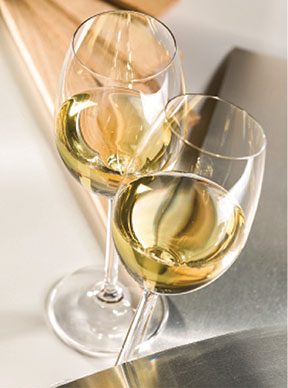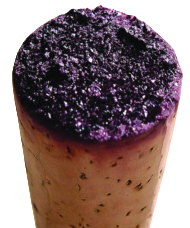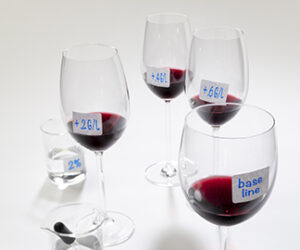 An oft written but perhaps somewhat vague wine descriptor is the term “balance.” There are several different ways wines may be in or out of balance, and the end of fermentation is a good time to assess the sensory attributes of your wine to determine if changes should be made to achieve a more balanced wine.
An oft written but perhaps somewhat vague wine descriptor is the term “balance.” There are several different ways wines may be in or out of balance, and the end of fermentation is a good time to assess the sensory attributes of your wine to determine if changes should be made to achieve a more balanced wine.
Balance is achieved when the different elements in a wine interact harmoniously, with no one aspect of the taste or aroma overpowering the others. Because no one aspect is dominating, each component of the wine may be experienced individually at different times and the interaction of these components together makes for a more pleasing and interesting experience. That sounds great, but what are we actually talking about? Let’s first split wine into the aromas we can smell and the taste and texture components we feel in the mouth.
Aroma
For our discussion, aroma will be considered as anything that can be smelled, no matter if it’s sniffing wine in the glass or during tasting wine in the mouth. Balance in terms of aroma can be expressed as a balance between the different aromatic elements in the wine (fruity or floral vs. oaky and spicy vs. herbal, earthy, vegetal). Hopefully the wine has achieved the level of fruitiness you desire through careful vineyard management, appropriate harvest timing, and good winemaking practice during fermentation. Fruity aromas must be found in the fruit because in traditional winemaking practice it is impossible to add these types of aromas unless you blend with another fruitier wine (wines with fruit juice, chocolate, or other additives are known as recipe wines, and while a legitimate category of production, won’t be considered in this article).
The one exception to the addition of aromas in traditional winemaking is aroma derived from oak aging. Depending on the oak source and level of toast, oak aromas can range from raw wood to vanilla, coconut, spicy, coffee, barbecue, and smoke aromas. The level of aroma impact on wine depends on the amount of chips or staves used (or percentage of new oak if barrels are used) and the amount of time the wine is stored in the barrel. I’m not sure I’d describe using oak barrels or alternatives as a “post-fermentation tweak,” but the addition of oak aromas will definitely change wine aroma profile and complexity. Besides aroma, compounds extracted from oak also supply body and astringency, which will be covered later in this article.
Not all wines need to be overtly fruity, but in general the less fruit or floral elements in the wine, the less other elements such as oak should be added as they may overpower the aroma profile and make the wine one-dimensional. Examples of wines that are less fruity include less-ripe Chardonnay, Pinot Blanc, Sémillon, Chenin Blanc, and sparkling wines. On the other end of the fruit spectrum, very fruity wine varieties and styles (Riesling, Gewürztraminer, and Muscats in whites, fruity Beaujolais styles in reds) generally are not oaked either; as these prominent aromas seem to be muddled and in conflict when oak is used.
Although fruity aroma may not be added to wine, it is possible to “unmask” some of the fruity aroma in wines that have slight faults such as rotten egg (hydrogen sulfide) or vegetal aromas (green pepper or cooked vegetable) by fining. Fining is a large and complex topic, but there are commercial fining agents that are recommended for specific purposes, one of which is aroma enhancement. Determining which fining agent to use and at what addition rate requires benchtop trials (see sidebar below). Many fining agents are relatively non-specific in their target, so some of the pleasant aromas may also be diminished by fining. Tank sparging with an inert gas may also help to lessen the aroma impact of some faults, but as in the case of fining, you will also be volatilizing and losing some of the good aroma compounds.
Taste
Balance with regard to taste is the other critical component of wine balance. Taste is generally considered to be perceived with the tongue and includes the sensations of: Sweet, sour, salty, bitter, and umami. In wine, the most important tastes are sweet, sour, and bitter. In addition, when discussing wine we also include touch perceptions from all over the mouth: Body (weight or viscosity of the liquid), astringency (drying or rough sensation), alcohol harshness, and carbon dioxide prickle.
In his book The Taste of Wine, Emile Peynaud gives a detailed framework about how the different taste components in wine interact. Peynaud stated that the main taste components effecting balance in white wines were sour (or acidity) and sweetness, while those affecting red wine balance are acidity, sweetness, and astringency. Wines that contain higher amounts of acid without sugar or the perception of sweetness may be described as tart, acidic, or green, while those containing too little acid or too much sugar may seem flabby, flat, or rich (sometimes called cloying in wine reviews). Wines with too much astringency can be described as severe, harsh, rough, and tannic. Wines with “balance” are described as well structured, round, mellow, or harmonious. Let’s explore the interaction of these components in more detail.
Sweet and Sour
The major factor in white wine balance is the interaction between acidity and perceived sweetness. The tastes of acidity and sweetness counteract each other. A simple example of this is lemon juice, a product so tart that few taste it alone, may be transformed into pleasantly refreshing lemonade by the addition of large quantities of sugar. Some wines, most commonly whites, contain some amount of sugar to counteract the acidity. A complicating factor in wine is that alcohol and chemical compounds derived from oak barrels can give us the impression of sweetness without sugar. Thus, higher alcohol wines and those exposed to new barrels, or oak alternatives, during aging can seem slightly sweet without actually containing any sugar. Polysaccharides from yeast autolysis, if yeast lees are left for a long period of time with wine, may also give the impression of fuller body and can lessen the impression of acidity.
To make an adjustment in sweetness or acidity, benchtop trials are recommended. Sugar additions are easy to calculate and will definitely improve the balance and pleasure of an acidic white (for example, off-dry Riesling). However, bottling with residual sugar can be difficult for many home winemakers due the potential for refermentation in bottle if yeast are not eliminated or inhibited.
Wines with residual sugar must be sterile filtered or sorbate must be added (sulfite levels drop over time, so sulfite alone will not inhibit yeast long-term). Home winemakers may prefer to de-acidify in order to achieve balance. If you do decide to add sugar before sterile bottling, wait until just before bottling, thus mitigating the chance of refermentation during cellar storage and filtration.
Acid additions are also relatively straightforward. An acid addition should have a direct effect on titratable acidity, but the pH impact will depend on the other ionic species in the wine (other acids, but also potassium ions). Most winemakers add tartaric acid to increase acidity because it is often the most abundant acid in wine and because it is stable (tartaric acid will not be degraded by lactic acid bacteria). A malic acid addition is also an option preferred by some white wine producers, and citric is occasionally added to whites. Both malic and citric acids may be metabolized by lactic acid bacteria, so their use should be considered in terms of whether malolactic fermentation will be utilized. Commercial winemakers are comfortable making acid additions up to about 2 g/L; but they get nervous about the impact of additions above this level to the final wine composition.
On the other end of the acidity spectrum, there are two common methods for de-acidification of wine: Chemical de-acidification using carbonates (potassium carbonate or bicarbonate) or microbial de-acidification using malolactic bacteria. For chemical de-acidification, there are online calculators that can help determine how much carbonate to add to obtain a desired drop in titratable acidity. My advice on de-acidification would be to go slow. Due to additional reactions not calculated in the standard equation, the actual drop in acidity can be much greater than the calculation. Therefore adding a quarter to half of the calculated amount and testing acidity before proceeding is the prudent approach.
Microbial de-acidification is a traditional method of removing excess acidity in cool climate whites and in most styles of red wine production. The amount of de-acidification depends on the malic acid content of the wine. This can be difficult to measure for home winemakers, so if microbial de-acidification is preferred the best method would be to complete the conversion and then measure pH and titratable acidity (TA) to decide if further de-acidification or acidification is necessary. Always taste the wine before making further adjustments; the numbers don’t always tell the whole story.
Astringency
Balance in red wines is more complicated than whites because reds contain a group of chemicals called tannins that give wines astringency. Astringency is not strictly a taste, instead it is the feeling of roughness or dryness inside the mouth caused by tannins, which are derived from the skins and seeds of grapes. Astringency levels in red wines vary significantly among grape varieties and wine styles. For instance, generally a Pinot Noir will be less astringent than a Cabernet Sauvignon. The feeling of astringency is increased when wine acidity is increased, so tart red wines are generally made to be less astringent in tannins in order to maintain a pleasing balance in taste. Astringency is also affected by sweetness, with increasing sweetness decreasing the feeling of astringency. Until recently, most red wines did not have residual sugar, but the perception of sweetness can be increased by increasing both the alcohol content and new
oak influence.
Because tannin is extracted from grape skins and seeds, the amount of tannin found in a finished wine depends on the amount present in the grape as well as the maceration type (punch down vs. pumpover) and frequency. In addition, tannin extraction is influenced by alcohol content and fermentation temperature (higher alcohol and temperature extract more tannin). Tannin level will continue increasing until the skins and seeds are pressed from the wine.
If too much tannin has been extracted for a particular wine style the wine will taste overly grippy, rough, or drying. Fining with egg white is a traditional method for reducing the tannin level in red wines. One to three egg whites per 60-gallon (227-L) barrel is a common range of addition, although there are also commercial preparations of egg albumen, which are easy to prepare and accurately dose. No matter which method is used, benchtop trials are required in order to determine optimum balance. Keep in mind that wine astringency changes over time; thus the main reason for aging red wines. Therefore a young red wine should probably seem slightly too tannic in order to achieve balance after several years of cellaring. It’s also important to remember that high acid level enhances the perception of astringency, so lowering the acidity can also make tannins seem less aggressive.
If a red wine does not contain enough tannin for its style it may seem thin, flat, or boring. Use of new oak cooperage, or oak alternatives, will add oak tannins to wine. Oak addition is a bit tricky, however, because oak also adds aromas and can add body and the perception of sweetness. Therefore, oak use must be integrated with goals for the aroma, structure (tannin), and sweetness/body perception of the wine. To adjust only the tannin profile, commercial additive suppliers offer a range of tannin products. Some of these products are meant to be used during fermentation, others during cellaring and aging, and finally some products are described as “finishing” tannins, used to tweak the wine balance close to bottling. These products differ in the source of the tannin (oak or tree nut tannin vs. grape-derived tannin) and their processing, so it is important to read the technical data sheets.
Balance Achieved?
Wines balanced between aroma and taste offer continuity and tell a unified story. If a wine smells herbal or slightly vegetal, the experienced taster might expect a somewhat tart, grippy wine that nonetheless could still be balanced. An overtly fruity wine is expected to have a more supple, fuller bodied, perhaps sweet taste. Wines that smell one way but taste another are often a disappointment.
Wines with a balanced taste profile of sweetness, sourness, and astringency are the goal, but there is still a lot of wiggle room for winemakers to express themselves stylistically. The winemaker may make a refreshing Riesling with high acidity and low alcohol, but moderated by a noticeable amount of residual sugar. Or make a tart, lively Pinot Noir with lower tannic astringency so the wine isn’t overly harsh. Or make a big, burly Cabernet with loads of astringency, but mellowed by high alcohol content and lower acidity. These wines will taste very different but each may still be considered a balanced wine if the interaction between the different tastes is harmonious.
Benchtop Trials (sidebar)
Benchtop trials are used to dial in sugar and acid additions as well as fining agents and other additives such as tannin. The agent of interest is added in a range of addition that covers the range of sensory interest (e.g. 0–2g/L tartaric acid addition, in steps of 0.5g/L) and then assessed using sensory analysis (smell and taste) to determine the optimum level to achieve balance in the wine. Trials are often set up directly in tasting glasses or in bottles. Additives should be mixed well. Most trials may be sampled immediately after addition, with the exception of tannins, which require several days to several weeks to integrate in the wine. Some winemakers also wait several hours to several days to allow fining agents to settle.
Determining the amount of an additive to add to a specific volume of benchtop trial solution requires an understanding of concentration units and often involves unit conversion (e.g. converting from mg to g, or from ppm to g/L).
For the mathematics averse, there are several online calculators that can help with benchtop trials. One I’ve found very useful is www.wineadds.com. This site not only calculates additive amounts based on the size of your wine lot, but most of the additive menus also contain a tab labeled “Bench Trials.” The Bench Trials tab will calculate additive amounts for a range of add rates. The sample volume is also adjustable.
Another useful benchtop trial calculation is available from the Australian Wine Research Institute at: https://www.awri.com.au/industry_support/winemaking_resources/calculators/. Clicking on the “Fining Trials” link, you can input additive rates and obtain addition amounts for each trial sample.
Benchtop trials in small volumes of wine may be problematic for home winemakers due to an inability to measure the small masses or volumes of additive required (often in the microgram or microliter range). One way to mitigate this problem is to use a larger trial volume. Another way is to dilute your additive in water and add using a micropipette. Both scales and micropipettes that measure in these ranges may be found online for reasonable prices, but I’ve found that measuring small volumes with a micropipette is more accurate and less expensive than purchasing a precision scale. With either method you should determine how to measure the accuracy of these instruments and plan to check your accuracy and precision periodically.







